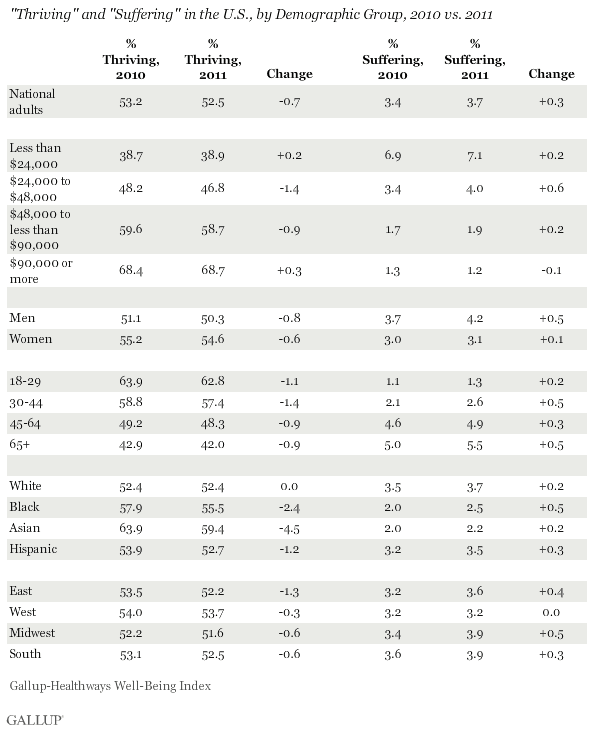WASHINGTON, D.C. -- Slightly fewer Americans, on average, were "thriving" in 2011 than were in 2010, while slightly more were "struggling" and "suffering," based on how they rate their own lives. The percentage thriving (52.5%) remains higher than it was during 2008 and 2009, but the percentage suffering (3.7%) in 2011 inched up to the level seen in 2009.

Gallup classifies Americans as "thriving," "struggling," or "suffering" according to how they rate their current and future lives on a ladder scale with steps numbered from 0 to 10 based on the Cantril Self-Anchoring Striving Scale. Those who rate their present life a 7 or higher and their live in five years an 8 or higher are classified as thriving, while those who rate both dimensions a 4 or lower are considered suffering. Respondents whose ratings fall in between are considered struggling.
In December, 51.9% of Americans were thriving and 3.5% were suffering, leaving 44.6% who were struggling. However, the percentages of Americans who were thriving in November and December were up from the percentages seen from August to October, including the 2011 low of 50.8% recorded in October.

Looking at the longer term, more than half of Americans have rated their lives well enough to be considered thriving since May 2009, signaling a turnaround in Americans' well-being following the global economic collapse. From October 2008 to March 2009, more Americans were struggling than thriving.
The percentage of Americans who rate their lives negatively enough to be considered suffering has remained relatively steady since April 2009, in the 3.1% to 4.0% range. Thus, while the 3.7% average for 2011 is up slightly from 2010 and even with 2009, it is a positive sign that the U.S. has not seen a large spike in suffering as other struggling economies, such as Greece, have.
Asian and black Americans downgraded their lives the most from 2010 to 2011, with their thriving percentages far more than among Americans on average. Middle-income Americans were more likely than higher- and lower-income Americans were to see decreases in thriving, while all Americans making less than $90,000 per year were more likely to be suffering.

Bottom Line
Americans, on average, became slightly more negative about their lives in 2011 than in 2010, after having become more positive in 2010 than they had been in 2008 and 2009 amid the recession. In December 2011, fewer Americans were thriving and more were struggling than at the same time a year before, but the situation was improved from what Gallup found from August to October. The uptick in thriving toward the end of the year coincides with an improvement in Americans' ratings of their standard of living, as well as lower unemployment and increased economic confidence. Further improvement in these areas could thus help to further lift American's life evaluation ratings.
At the same time, leaders should closely monitor the percentage of Americans who are suffering, which increased in 2011 to the level seen in 2009. This increase is nowhere near what Gallup documented in other nations in 2011 and remains relatively low compared with the worldwide measures. However, a sharp increase in the percentage of Americans' suffering would serve as a warning sign of increased distress within the U.S. population that could still surface in the current fragile economic climate.
About the Gallup-Healthways Well-Being Index
The Gallup-Healthways Well-Being Index tracks well-being in the U.S., U.K., and Germany and provides best-in-class solutions for a healthier world. To learn more, please visit well-beingindex.com.
Survey Methods
Results are based on telephone interviews conducted as part of the Gallup-Healthways Well-Being Index survey Jan. 1-Dec. 31, 2011, with a random sample of 334,047 adults, aged 18 and older, living in all 50 U.S. states and the District of Columbia, selected using random-digit-dial sampling.
For results based on the total sample of national adults, one can say with 95% confidence that the maximum margin of sampling error is ±0.2 percentage points.
For results based on subgroups, one can say with 95% confidence that the maximum margin of sampling error is ±1.9 percentage points.
Interviews are conducted with respondents on landline telephones and cellular phones, with interviews conducted in Spanish for respondents who are primarily Spanish-speaking. Each sample includes a minimum quota of 400 cell phone respondents and 600 landline respondents per 1,000 national adults, with additional minimum quotas among landline respondents by region. Landline telephone numbers are chosen at random among listed telephone numbers. Cell phone numbers are selected using random-digit-dial methods. Landline respondents are chosen at random within each household on the basis of which member had the most recent birthday.
Samples are weighted by gender, age, race, Hispanic ethnicity, education, region, adults in the household, and phone status (cell phone only/landline only/both, cell phone mostly, and having an unlisted landline number). Demographic weighting targets are based on the March 2010 Current Population Survey figures for the aged 18 and older non-institutionalized population living in U.S. telephone households. All reported margins of sampling error include the computed design effects for weighting and sample design.
In addition to sampling error, question wording and practical difficulties in conducting surveys can introduce error or bias into the findings of public opinion polls.
For more details on Gallup's polling methodology, visit www.gallup.com.
